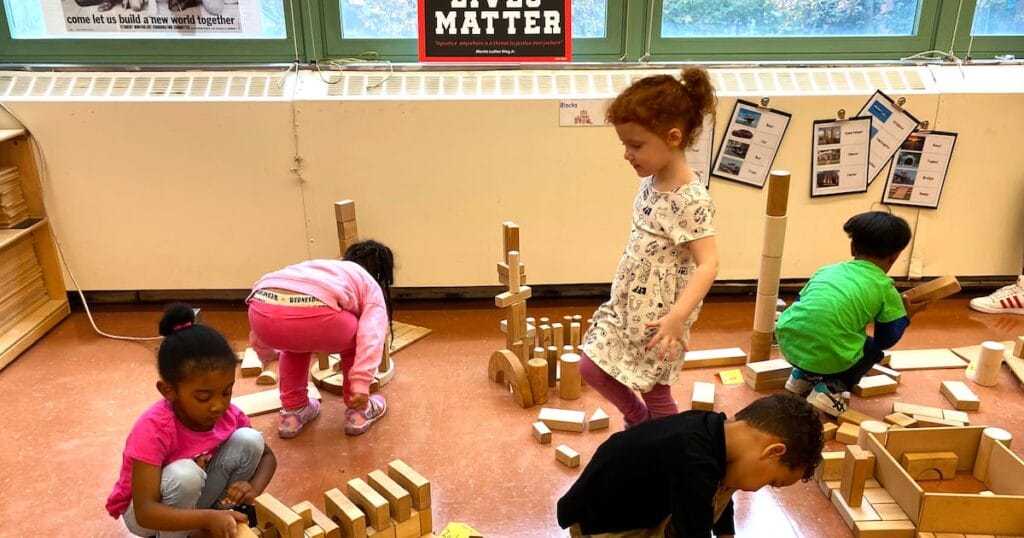Sign up for Chalkbeat New York’s free daily newsletter to get essential news about NYC’s public schools delivered to your inbox.
Mayoral frontrunner Zohran Mamdani’s big education agenda, free child care for all, aims to keep families with young children in New York City.
But would the program, costing an estimated $6 billion a year, convince families to stay for elementary school?
Child care is just one piece of an interconnected web of affordability and education issues that influence whether families leave the city when they have children. Also in play: housing, availability of after-school programs, school quality, and navigating school admissions, whether for kindergarten or looking ahead to middle and high school. For many, having a second or third child also changes the calculus, several parents told Chalkbeat.
The city’s free prekindergarten program didn’t stop thousands of families who applied to the program for 4-year-olds last year from leaving the public school system before kindergarten this year, according to Education Department application data.
Roughly 52,400 children submitted applications for pre-K seats in the 2024-25 school year. But when it came time for those children to apply to kindergarten the following year, there was a considerable dropoff to about 46,370, a dip of about 12%.
In the prior two years, the number of kindergarten and preschool applications more closely matched.
It seems unlikely that the difference is explained by families moving to private school for kindergarten. Enrollment in the early grades in private schools has declined the last few years, said Ryan Coughlan, an associate professor at Baruch College’s Marxe School of Public and International Affairs. (Enrollment at private schools has increased at middle and high schools.)
Alan Gu’s twins would have entered kindergarten in New York City this year, but he and his husband left their brownstone in Brooklyn for Jersey City. Finding a suitable public school with an affordable after-school program that aligned with their work schedules felt untenable.
Concerned about the performance of the neighborhood school, Gu felt fortunate last year to get his kids into a sought-after free pre-K program in Manhattan’s Chinatown, but that required waking up at 5:30 a.m. and commuting about an hour on two subway lines to a 15-minute walk with his then 4-year-olds. His kids were exhausted and mentally drained. So was Gu.
For the first three weeks, the school offered no after-care program. When after-care finally launched, it ended at 5 p.m., forcing Gu to leave work early, around 4 p.m. Sometimes, he’d bring his kids back to his office so he could get more work done. Often he was late and felt like a “bad parent.” The cost, $150 per child each week, didn’t make sense to him.
Gu, who works in human resources and had lived in New York for more than 10 years, previously thought he “would die” before moving to New Jersey.
Then he visited the Newport area in Jersey City. It felt safe and had about a 25-minute commute to Manhattan. He was impressed by the local public school.
“Not only were they helpful, it didn’t seem like it was a secret on how to get into the school,” Gu said.
The school had morning care starting at 7 a.m. and after-care lasting until 6 p.m. — and it cost less than his kids’ program in Chinatown. He pulled the twins out and moved across the Hudson River two months before the school year ended.
Now that they’re not traveling nearly an hour each way to school, his twins have energy for an array of activities, like ballet, tap, hip hop, and jiu jitsu — paying almost less combined than for their swim lessons in the city. And he no longer feels like he has to fight for things, like he did in the city, such as speech therapy services for his children.
Out of 14 families of his twins’ pre-K class, only three stayed in the city for kindergarten, he said.
“I felt like New York City did not want me there once I had kids,” Gu said.
Schools and housing often a reason for leaving the city
The mayoral candidates have all embraced the need to bolster child care, with Mamdani making it one of his three signature platforms, alongside a rent freeze and free buses.
“It’s pricing out New Yorkers from the city,” he said during last week’s debate.
Education Department officials said a variety of factors might influence application rate fluctuations, and in summer 2024, they did a research survey to help understand how families make school choices. The survey found that 40% left the school system because they moved out of the city, and of those who left, the top three reasons were: a “better environment to raise kids,” “concerns about schools,” and “more housing space.”
Kristyna Frantz, a mom to a preschooler and twin babies, left in December after a decade in Washington Heights, moving to New Jersey’s Union County and commuting more than an hour to her communications job in the Financial District.
She had spaced her pregnancies so the older would be in 3K, the city’s free pre-K program for 3-year-olds, when the second was born and could be in day care. But having twins changed everything. The day care at her older son’s program increased in price more than 11% from when he started as a 5-month old, bringing the total to more than $2,000 a month per kid, which was prohibitive for her.
It sped up their timeline to move to New Jersey, where her husband is from, and where her in-laws still live and could provide an extra layer of child care.
“The 3-K was really what got my husband to stay for our first kid,” Frantz said. She believes the economics would have worked if they had free or subsidized child care for the twins. “We could have crunched the numbers and I could have said, ‘I know you want to move to New Jersey and mow the lawn, but this math isn’t mathing.”
Both Frantz and Gu have been advocating for affordable child care through the grassroots group New Yorkers United for Child Care, which on Wednesday released a roadmap on how to achieve free child care for 2-year-olds within four years. Along with the policy organization United Neighborhood Houses, they called for an initial focus on the city’s highest poverty areas.
Rebecca Bailin, executive director of New Yorkers United for Child Care, believes the initiative is key to keep the city’s diversity and help families here grow.
“We have seen people say when their kids are 0 to 2: I just have to make it to 3K or pre-K,’” said Bailin, “but I imagine as they’re thinking about that second kid they’re realizing, ‘Oh God, I have to do this all over again and potentially get a bigger apartment and pay for after care.”
Families with young kids flee NYC at double the rate
Households with young children were twice as likely to leave New York City than those without young children, according to a 2024 analysis from the Fiscal Policy Institute. Black and Latino New Yorkers were also leaving at higher rates, the report found. In terms of school demographics, the number of Black students fell 13% over the past five years, along with a 6% drop in the number of white students.
The lack of affordable housing forced Jasmine White to leave Coney Island, the Brooklyn neighborhood where she was born and raised.

On her salary providing physical assistance to adults with disabilities, White barely had savings after paying for her car insurance, cellphone, groceries, and her $340 weekly child care bill for her daughter — even while staying with her mom.
“Add it up after a while, you’re just left with lunch money,” White said.
She moved to Maryland the summer before the 2020-21 school year, during the COVID pandemic, after her daughter had been wait-listed at a kindergarten program White hoped she could attend instead of the local school. By the time her daughter got off the wait-list, they were already gone. And now White, who works as an office manager, says she has more than just lunch money.
Coughlan, the Baruch professor, said there’s been a lot more volatility since the pandemic in terms of families leaving New York City.
“There’s all kinds of questions around where people are choosing to live post-COVID,” he said, noting that some families are now more inclined to leave, worried about a repeat pandemic.
While schools often help root families to their neighborhoods, he’s also seen a rise in “decoupling school from place” — when children don’t attend local schools — which can leave people “feeling untethered,” and that could affect whether families decide to stay as well.
“It’s untenable to pay for child care in the city and be a person who makes a normal income and so that needs to be addressed,” Coughlan said. “But I also think we need to think of how people remain connected beyond that.”
Amy Zimmer is the bureau chief for Chalkbeat New York. Contact Amy atazimmer@chalkbeat.org.
Amy Zimmer 2025-10-22 19:00:47
Source link

